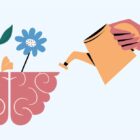The brain is continually changing, learning, and evolving. The human brain can change its own structure and function with thought and experience, turning on its own genes to change its circuitry, reorganize itself and change its operation, is the most essential alteration in our understanding of the brain.
Our mind has several layers embedded into it. It is like an ice berg. The first layer is the Conscious, (everything that you are aware of in this present moment) which is just the 12 % of the iceberg, so to say the tip of it. Second layer is the Sub-conscious and then the Un-conscious, these are the remaining 88% of the iceberg (these contain all the repressed memories, flight & fight mechanism, and all the positive & negative associations we have made throughout life)

When we “learn” something, the experience is physically stored within networks of brain cells called “neurons”. These networks actually form in the sub-conscious mind, determining how our brain interprets the world around us and governing how we feel from moment to moment. These memories included past experiences which our conscious mind is often unaware that they have any impact whatsoever. But since all the memories are physically stored in brain, they can pop up outside of control as a response to a trigger.

Because of how traumatization in particular is embedded in our brains, we are often at a loss to understand why our thoughts, feelings and even physical bodies behave the way they do.
For instance, all of us have experienced loud storms in childhood, but only some of us will remain affected by it negatively. Here for now, it is sufficient to know that when negative reactions and behaviors in the present can be tracked directly back to an early memory (even back to mother’s womb), we define those memories as “unprocessed”- meaning that they are stored in the brain in a way that still holds emotions, physical sensations and beliefs that were experienced earlier in life.
So, the stormy night Raj was frightened as a child, and had the belief that he was in danger. His parents did not come in the room when he cried, which also gave him a feeling that he will be abandoned when he really needs them.
This memory of the 5-year-old child later in adulthood is then triggered & stimulated when he is left alone by a friend. At this point then he no longer functions as a 28-year-old, but rather alike a frightened little boy left in the dark. We can see the connection, given that the storm and being left alone are both associated with abandonment. As such, he sub-consciously experiences the event as “being in danger”.
We experience these types of connections all the time. It’s generally the reason for all of the characteristics we love or hate in ourselves & in those around us. It is simply a part of how our brain functions in order to make sense of the world.
But, identifying the memory connections is just the first step in changing how we think, act or feel. It is not just understanding where something comes from but also knowing what to do about it that’s important.
“Mind has no Matter; and yet, it is only mind that matters”
Here we share a therapeutic technique, famously known as Clinical Hypnotherapy.
“Hypnosis can be seen as ‘a waking state of awareness, (or consciousness), in which a person’s attention is detached from his or her immediate environment and is absorbed by inner experiences such as feelings, cognition and imagery’. Hypnotic induction involves focusing of attention and imaginative involvement to the point where what is being imagined feels real. By the use and acceptance of suggestions, the clinician and patient construct a hypnotic reality.” (Ann Williamson, 2019)

Hypnosis begins by transforming our ordinary consciousness to an altered state of consciousness. Every experience of ours, will form a lesson or “program” in our sub-conscious mind in order to protect us from danger. For example, when we touch a hot kettle for the first time, immediately our hand gets burnt and this incident forms a “program” in the sub-conscious mind to prevent us to touch a hot kettle with bare hand again. The body will give priority to “programs” in sub-conscious mind because the body cannot afford the conscious mind to take time to do analysis when the incident is potentially dangerous.
However, some “program” may not be appropriate or not applicable when time past. Such as, a person experiencing a car accident may form a “program” to prevent him to drive again. Driving phobia can protect him from future potential car accident but is not appropriate for his social life.
In Clinical Hypnotherapy, the therapist will induce the patient to a relaxed, comfortable state of mind call trance stage. In trance stage, the patient’s conscious mind (which is only 10% of the conscious iceberg) is at rest and sub-conscious mind (the remaining 88%) becomes more active and receptive. The hypnotherapist will lead the patient to communicate with the sub-conscious mind and seek the agreement from sub-conscious mind to replace the unwanted “program” with a more favourable program.
In the process of hypnotherapy, the patient is “here & now” and “there & then” in order to be able to interact with the hypnotherapist and their sub-conscious mind. The role of a hypnotherapist is a facilitator of the healing process. Throughout the process of hypnosis, hypnotic suggestions are used to facilitate the client’s journey. The patient has the power to pause, change or stop the therapy procedure at any junction of time.
Case Study:
Mayank a 43-year-old (names and details are altered for the purposes of confidentiality) came in because he was petrified of the uncertainty, unknown and any negative event that he came across in life. He after the initial phases of therapeutic process was taken into a state of hypnosis to find the roots/trigger of the fear, in his subconscious mind. In this case, his mind took him back to when he was a premature newborn child, there in the prenatal unit, lying in an incubator with tubes attached surrounded by nurses who were having a dialogue amongst themselves as they observed and treated this child (him). In clients verbatim, the dialogue by the nurses was “this poor child, he is not going to make it”. This dialogue and the energy coming from it, somehow got engraved into this infants mind, and then got stimulated and triggered throughout his life.
Under hypnosis when the client was taken back to this trigger, and he heard this dialogue, it came to his conscious awareness that this was the cause of it and helped him be aware and comes on terms with it. (Here to add on you must know that just becoming aware of our triggers and our uncomfortable emotions significantly helps lowering the intensity of it)
This man, then addresses his trauma that he had been carrying on his shoulder like a mountain for so many years. He was encouraged & guided to have a dialogue with the nurses, sharing with them that they can let go of the worry for his survival as he did make it through. The fear of unknown then declined subsequently and he became more in charge of his emotions, life, and physical wellbeing.
Sugarman & Linden (2020) argues that hypnosis has emerged as a multidimensional and wide discipline for inducing change in the mind. The technique has been used in various ways to assess embodied experiences as part of the therapeutic process. The therapy can be used as a communication and engagement tool that therapists adopt to connect with the mind, thereby facilitating their access to and heal & overcome the traumatic experiences.
The main aim of this process is to help individuals shift their minds from the unhealthy status of trauma to resiliency and internal renewal. The efficacy of hypnosis in managing trauma has been determined through various studies. It has been determined that the therapy can be used to influence the mind and make it elicit reactions that activate individuals’ innate resources for change. This way, the therapy can help re-process memories stored in the subconscious mind to help the individual heal from the traumatic experiences, circumstances or symptoms of any prevailing mental and/or physical illnesses.
Clinical Hypnotherapy is just one modality of treating traumas. The world of mental has many a tool that can aid and facilitate an individual’s journey towards self-healing. Some of these tools are Expressive arts based therapy, trauma tapping and havening techniques, Sound and resonance therapy, and clinical acupressure.
If you or someone you know is or has been struggling for a prolonged period of time now, please reach out to your nearest mental health professional. To get in touch with our experts, drop an email at info@sfct.in




Recent Comments